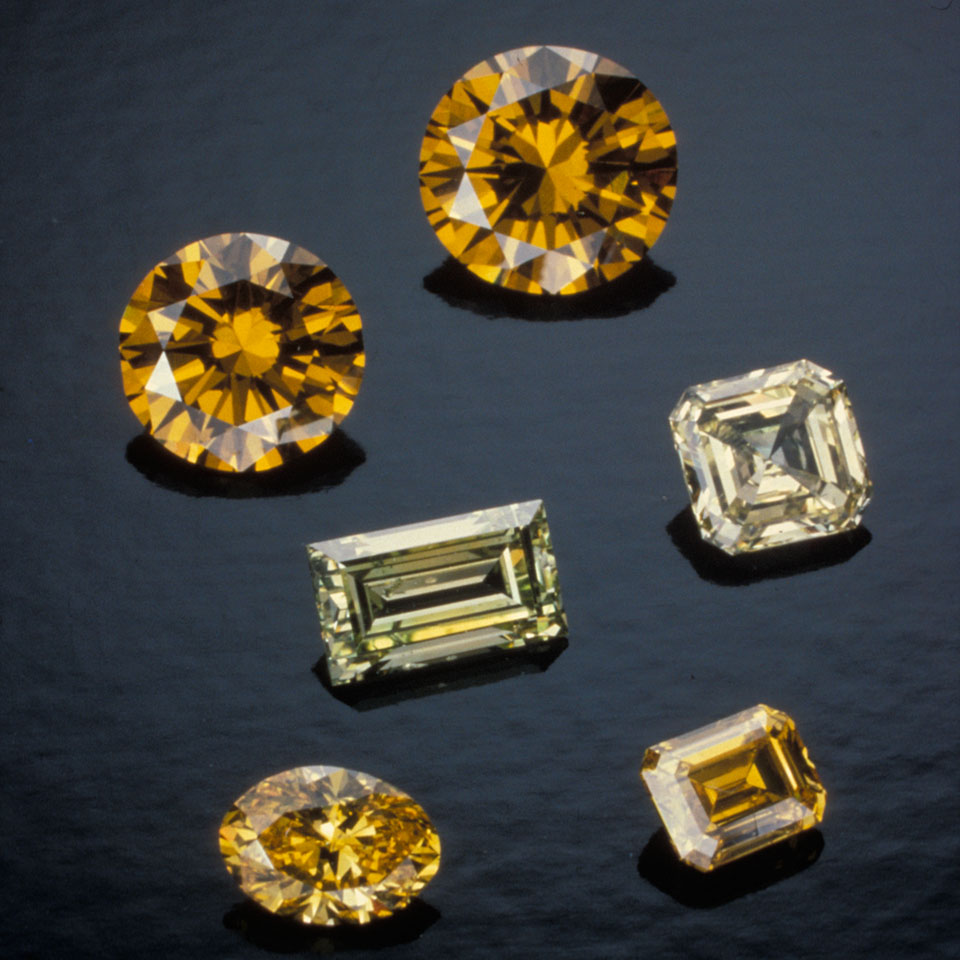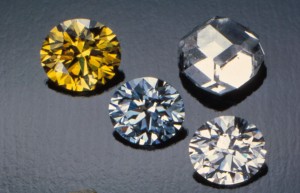Many jewelry shoppers, for reasons varying from cost to personal preference, consider “diamond alternatives” in place of a natural diamond. However, when asking a jewelry retailer about diamond alternatives, you are likely to receive a number of different answers.
Buying options range from synthetic diamonds, diamond simulants and treated diamond simulants. So what’s the difference? Just as GIA has put together tips to use when shopping for natural diamonds, consider this list of definitions and buying considerations your go-to guide when shopping for alternatives to natural diamonds.
Synthetic diamonds: The man-made version of “the real thing”
Synthetic diamonds have the same physical, optical and chemical properties as natural diamonds. This means that they are essentially the same as a natural diamonds, the difference being that they are grown in a laboratory as opposed to being grown in the ground. Synthetic diamonds are produced using one of two processes – High Pressure/High Temperature (HPHT) or Chemical Vapor Deposition (CVD). Diamonds—both natural and synthetic—are the hardest mineral on Earth; 10 on the Mohs scale. Their toughness is good to excellent and they are incredibly durable to heat, light and chemicals.
Gem-quality synthetic diamonds have been available to consumers since the mid-1980s, and with their rising popularity GIA developed a distinct diamond grading report (link to a sample report) for synthetics to eliminate any consumer confusion between the two.
Simulants: Other gemstones that look like a diamond but have different properties
Diamond simulants do a good job of looking like a diamond, but are in fact very different than diamond. They fall into two categories: natural gemstones and synthetics. Examples of natural gemstones that simulate or imitate the look of diamond are colorless sapphire (also called white sapphire) and colorless zircon. While colorless sapphire has a hardness of 9 on the Mohs scale and its toughness is excellent–making its durability somewhat comparable to a diamond–it is less brilliant than a natural diamond. Colorless zircon, one of the most brilliant non-diamond gems, was used as a lower-cost diamond alternative in the 19th century. However, with a hardness of 6-7.5 on the Mohs scale, it requires more care and should never be cleaned with an ultrasonic or steam cleaner.
The most common diamond simulant that is a synthetic gemstone is synthetic cubic zirconia (CZ). CZ is readily available and remains a popular choice based on its affordability. CZ can be a convincing diamond simulant in small sizes. However, if CZ is colorless, its color has been shown to yellow over time and it can be somewhat brittle.
Synthetic moissanite, also known as silicon carbide (SiC), is another popular diamond simulant. It is produced in a near-colorless form and its brilliance is only slightly less than a natural diamond. With a hardness of 9 ¼ and excellent toughness, its durability also competes with a natural diamond. Unlike a natural diamond, where its color can have a slightly yellowish hue, synthetic moissanite can have a slightly greenish or greyish hue.
GIA tests every stone submitted for a grading report to verify that it is, in fact, a natural or a synthetic diamond. GIA does not issue grading reports for gemstones other than diamond; these gems receive identification reports instead.
Hybrids: Non-diamond materials that are coated with diamond materials
Diamond hybrid is a term some manufacturers use to describe a product that is a natural or synthetic gemstone coated with a thin layer of synthetic diamond or diamond-like carbon (DLC). These coatings, while durable, are not permanent and can be removed.
The FTC issues Guides for the Jewelry Industry and sellers are required to disclose treatments and synthetics.
Four tips before finalizing a purchase
- Ask about the return policy. If you get home and have concerns, you’ll know what your options are.
- Ask about the stone’s care. Durability varies between diamond alternative options, making the care instructions different for each.
- For natural and synthetic diamonds, ask for a grading report. For other types of gemstones, ask for an identification report.
- If you’re considering a diamond simulant for an engagement ring, be sure to look at the stone on your hand before you purchase it. While diamond simulants are meant to look like natural diamonds, their appearances do vary between the different options.
Have you considered a diamond alternative or own one? Please share your experience of either shopping for or owning a synthetic diamond or a diamond simulant.
Custom Field: Array



